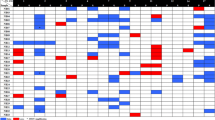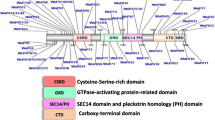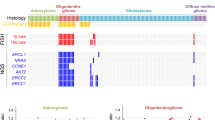Abstract
Purpose
Dysembryoplastic neuroepithelial tumors (DNTs) are slow-growing glioneuronal tumors, and their genetic backgrounds are getting unveiled. Recently, fibroblast growth factor receptor 1 internal tandem duplication (FGFR1-ITD) of the tyrosine kinase domain (TKD) has been demonstrated by whole-genome sequencing.
Methods and Results
Here, we analyzed 22 DNTs using multiplex ligation-dependent probe amplification (MLPA) with formalin-fixed paraffin-embedded specimens and found a copy number gain in TKD of FGFR1 (13 cases, 59%), which suggested the presence of FGFR1-ITD. Another 5 DNTs harbored FGFR1 hot spot mutations including a double mutant case, and FGFR1 alterations were detected in 18 DNTs (82%). The BRAF V600E mutation, another important mutation in DNTs, was not observed.
Conclusions
With recent findings of less frequent or absent FGFR1-ITD in pilocytic astrocytomas or rosette-forming glioneuronal tumors, the analysis of FGFR1 aberrations, especially FGFR1-ITD, was suggested to be helpful to discriminate DNTs from their histological mimics.



Similar content being viewed by others
References
Daumas-Duport C, Scheithauer BW, Chodkiewicz JP, Laws ER Jr, Vedrenne C (1988) Dysembryoplastic neuroepithelial tumor: a surgically curable tumor of young patients with intractable partial seizures. Report of thirty-nine cases. Neurosurgery 23:545–556
Louis DN, Ohgaki H, Wiestler O et al (2016) World Health Organization classification of tumours of the central nervous system, 4th edn. International Agency for Research on Cancer (IARC), Lyon
Kakkar A, Majumdar A, Kumar A et al (2016) Alterations in BRAF gene, and enhanced mTOR and MAPK signaling in dysembryoplastic neuroepithelial tumors (DNTs). Epilepsy Res 127:141–151
Sontowska I, Matyja E, Malejczyk J, Grajkowska W (2017) Dysembryoplastic neuroepithelial tumour: insight into the pathology and pathogenesis. Folia Neuropathol 55:1–13
Prabowo AS, Iyer AM, Veersema TJ et al (2014) BRAF V600E mutation is associated with mTOR signaling activation in glioneuronal tumors. Brain Pathol 24:52–66
Chappé C, Padovani L, Scavarda D et al (2013) Dysembryoplastic neuroepithelial tumors share with pleomorphic xanthoastrocytomas and gangliogliomas BRAF V600E mutation and expression. Brain Pathol 23:574–583
Rivera B, Gayden T, Carrot-Zhang J et al (2016) Germline and somatic FGFR1 abnormalities in dysembryoplastic neuroepithelial tumors. Acta Neuropathol 131:847–863
Zhang J, Wu G, Miller CP et al (2013) Whole-genome sequencing identifies genetic alterations in pediatric low-grade gliomas. Nat Genet 45:602–612
Qaddoumi I, Orisme W, Wen J et al (2016) Genetic alterations in uncommon low-grade neuroepithelial tumors: BRAF, FGFR1, and MYB mutations occur at high frequency and align with morphology. Acta Neuropathol 131:833–845
Fina F, Barets D, Colin C et al (2017) Droplet digital PCR is a powerful technique to demonstrate frequent FGFR1 duplication in dysembryoplastic neuroepithelial tumors. Oncotarget 8:2104–2113
Hömig-Hölzel C, Savola S (2012) Multiplex ligation-dependent probe amplification (MLPA) in tumor diagnostics and prognostics. Diagn Mol Pathol 21:189–206
Schouten JP, McElgunn CJ, Waaijer R, Zwijnenburg D, Diepvens F, Pals G (2002) Relative quantification of 40 nucleic acid sequences by multiplex ligation-dependent probe amplification. Nucleic Acids Res 30:e57
Schindler G, Capper D, Meyer J et al (2011) Analysis of BRAF V600E mutation in 1,320 nervous system tumors reveals high mutation frequencies in pleomorphic xanthoastrocytoma, ganglioglioma and extra-cerebellar pilocytic astrocytoma. Acta Neuropathol 121:397–405
Gessi M, Moneim YA, Hammes J et al (2014) FGFR1 mutations in rosette-forming glioneuronal tumors of the fourth ventricle. J Neuropathol Exp Neurol 73:580–584
Kita D, Yonekawa Y, Weller M, Ohgaki H (2007) PIK3CA alterations in primary (de novo) and secondary glioblastomas. Acta Neuropathol 113:295–302
Jones DT, Hutter B, Jäger N et al (2013) Recurrent somatic alterations of FGFR1 and NTRK2 in pilocytic astrocytoma. Nat Genet 45:927–932
Matsumura N, Nobusawa S, Ikota H et al (2015) Coexpression of cyclin D1 and alpha-internexin in oligodendroglial tumors. Brain Tumor Pathol 32:261–267
Kuchelmeister K, Demirel T, Schlörer E, Bergmann M, Gullotta F (1995) Dysembryoplastic neuroepithelial tumour of the cerebellum. Acta Neuropathol 89:385–390
Eye PG, Davidson L, Malafronte PJ, Cantrell S, Theeler BJ (2017) PIK3CA mutation in a mixed dysembryoplastic neuroepithelial tumor and rosette forming glioneuronal tumor, a case report and literature review. J Neurol Sci 373:280–284
Sumitomo N, Ishiyama A, Shibuya M et al (2018) Intractable epilepsy due to a rosette-forming glioneuronal tumor with a dysembryoplastic neuroepithelial background. Neuropathology 38:300–304
Liao JM, Wang W, Xie J, Wu HB (2018) Dysembryoplastic neuroepithelial tumor-like pilocytic astrocytoma: a case report. Medicine (Baltimore) 97:e10755. https://doi.org/10.1097/MD.0000000000010755
Appay R, Fina F, Macagno N et al (2018) Duplications of KIAA1549 and BRAF screening by Droplet Digital PCR from formalin-fixed paraffin-embedded DNA is an accurate alternative for KIAA1549-BRAF fusion detection in pilocytic astrocytomas. Mod Pathol. https://doi.org/10.1038/s41379-018-0050-6
Ellezam B, Theeler BJ, Luthra R, Adesina AM, Aldape KD, Gilbert MR (2012) Recurrent PIK3CA mutations in rosette-forming glioneuronal tumor. Acta Neuropathol 123:285–287
Lin FY, Bergstrom K, Person R et al (2016) Integrated tumor and germline whole-exome sequencing identifies mutations in MAPK and PI3K pathway genes in an adolescent with rosette-forming glioneuronal tumor of the fourth ventricle. Cold Spring Harb Mol Case Stud 2:a001057
Acknowledgements
We thank Dr. Shigeru Nishizawa (Hospital of the University of Occupational and Environmental Health) for providing a valuable case.
Author information
Authors and Affiliations
Corresponding author
Ethics declarations
Conflict of interest
The authors declare that they have no conflict of interest.
Additional information
Publisher’s Note
Springer Nature remains neutral with regard to jurisdictional claims in published maps and institutional affiliations.
Rights and permissions
About this article
Cite this article
Matsumura, N., Nobusawa, S., Ito, J. et al. Multiplex ligation-dependent probe amplification analysis is useful for detecting a copy number gain of the FGFR1 tyrosine kinase domain in dysembryoplastic neuroepithelial tumors. J Neurooncol 143, 27–33 (2019). https://doi.org/10.1007/s11060-019-03138-7
Received:
Accepted:
Published:
Issue Date:
DOI: https://doi.org/10.1007/s11060-019-03138-7




